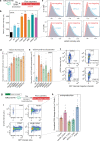Rare deleterious germline variants and risk of lung cancer
- PMID: 33594163
- PMCID: PMC7887261
- DOI: 10.1038/s41698-021-00146-7
Rare deleterious germline variants and risk of lung cancer
Abstract
Recent studies suggest that rare variants exhibit stronger effect sizes and might play a crucial role in the etiology of lung cancers (LC). Whole exome plus targeted sequencing of germline DNA was performed on 1045 LC cases and 885 controls in the discovery set. To unveil the inherited causal variants, we focused on rare and predicted deleterious variants and small indels enriched in cases or controls. Promising candidates were further validated in a series of 26,803 LCs and 555,107 controls. During discovery, we identified 25 rare deleterious variants associated with LC susceptibility, including 13 reported in ClinVar. Of the five validated candidates, we discovered two pathogenic variants in known LC susceptibility loci, ATM p.V2716A (Odds Ratio [OR] 19.55, 95%CI 5.04-75.6) and MPZL2 p.I24M frameshift deletion (OR 3.88, 95%CI 1.71-8.8); and three in novel LC susceptibility genes, POMC c.*28delT at 3' UTR (OR 4.33, 95%CI 2.03-9.24), STAU2 p.N364M frameshift deletion (OR 4.48, 95%CI 1.73-11.55), and MLNR p.Q334V frameshift deletion (OR 2.69, 95%CI 1.33-5.43). The potential cancer-promoting role of selected candidate genes and variants was further supported by endogenous DNA damage assays. Our analyses led to the identification of new rare deleterious variants with LC susceptibility. However, in-depth mechanistic studies are still needed to evaluate the pathogenic effects of these specific alleles.
Conflict of interest statement
E.K.S. reports institutional grant funding from Bayer and GlaxoSmithKline. Other authors declare no conflict of interest.
Figures


References
Grants and funding
- R01 CA060691/CA/NCI NIH HHS/United States
- U19 CA203654/CA/NCI NIH HHS/United States
- R01 CA084354/CA/NCI NIH HHS/United States
- R01 HL110883/HL/NHLBI NIH HHS/United States
- U01 CA076293/CA/NCI NIH HHS/United States
- R01 CA080127/CA/NCI NIH HHS/United States
- R01 CA141769/CA/NCI NIH HHS/United States
- P50 CA090578/CA/NCI NIH HHS/United States
- P30 CA022453/CA/NCI NIH HHS/United States
- U01 CA243483/CA/NCI NIH HHS/United States
- S10 RR024574/RR/NCRR NIH HHS/United States
- R01 CA134682/CA/NCI NIH HHS/United States
- R01 CA134433/CA/NCI NIH HHS/United States
- R01 HL113264/HL/NHLBI NIH HHS/United States
- R01 HL082487/HL/NHLBI NIH HHS/United States
- R01 CA250905/CA/NCI NIH HHS/United States
- U19 CA148127/CA/NCI NIH HHS/United States
- P20 GM103534/GM/NIGMS NIH HHS/United States
- R01 CA092824/CA/NCI NIH HHS/United States
- R01 CA087895/CA/NCI NIH HHS/United States
- U01 HL089897/HL/NHLBI NIH HHS/United States
- K07 CA181480/CA/NCI NIH HHS/United States
- HHSN268201100011I/HL/NHLBI NIH HHS/United States
- HHSN268201100011C/HL/NHLBI NIH HHS/United States
- R01 CA127219/CA/NCI NIH HHS/United States
- R01 CA074386/CA/NCI NIH HHS/United States
- P30 CA023108/CA/NCI NIH HHS/United States
- U01 HL089856/HL/NHLBI NIH HHS/United States
- HHSN261201300011C/RC/CCR NIH HHS/United States
- HHSN268200782096C/HG/NHGRI NIH HHS/United States
- P30 ES006096/ES/NIEHS NIH HHS/United States
- P30 ES030285/ES/NIEHS NIH HHS/United States
- P30 CA125123/CA/NCI NIH HHS/United States
- DP1 AG072751/AG/NIA NIH HHS/United States
- HHSN268201200007C/HL/NHLBI NIH HHS/United States
- R35 GM122598/GM/NIGMS NIH HHS/United States
- U01 CA209414/CA/NCI NIH HHS/United States
- R03 CA077118/CA/NCI NIH HHS/United States
- DP1 CA174424/CA/NCI NIH HHS/United States
- 001/WHO_/World Health Organization/International
- N01 HG065404/HG/NHGRI NIH HHS/United States
LinkOut - more resources
Full Text Sources
Other Literature Sources
Medical
Research Materials
Miscellaneous

